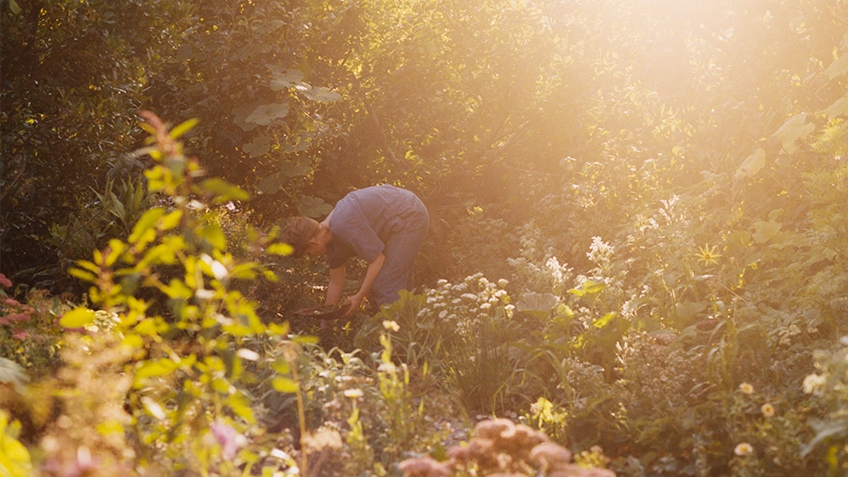BEAUTIFUL & PRODUCTIVE GARDENS: POLYCULTURE SYSTEMS FOR GROWING FOOD

What is polyculture?
At this point you might be wondering what a polyculture system is? The short answer is that it follows what nature does. It is a mixture, a little bit of everything, a muddle, a diversity of plants, a combination as opposed to a monoculture which is a single species usually grown at optimum spacing for speed of growth.
Polyculture can be wild and untamed, a space where you forage for food at the whim of nature’s offering at that moment, or it can be very intensive and considered, a careful grouping of plants that will not inhibit each other’s progress by competing for resources. In order for polycultures to work you must understand what happens both above and below ground. If you know what a plant’s root mass looks like, then you’ve won half the battle in knowing who likes to be in bed with whom.
Why bother?
It’s entirely appropriate to ask the question why you’d go to the trouble of mixing everything up if ideal growth can be achieved by growing a single species. The answer is that nature doesn’t like a monoculture, she likes diversity.
When a garden is healthy, abundant and productive it is diversity that makes it thrive. There are many players in the garden – beetles, worms, bees, millipedes, slugs, snails, nematodes, voles, moles, rabbits, squirrels, pigeons, songbirds, pets, lizards, mushrooms and on and on down to tiny things we can barely see with a naked eye and many, many more that we can’t.
How to organise your own polyculture system
Full Sun: Glade and Upper Storey Plants
Those that like to bask in the sun fall into two very different groups. The tallest of these are the upper storey plants, which in this case are mostly fruit trees. Medlars and a few pears are the most shade tolerant of these, the others need as much sun as they can get to give ripe, heavy crops. At the other end of the spectrum are glade plants which are mostly herbaceous, and annual plants that have evolved either from the open glades found in woodland, when large mature trees topple and suddenly allow light in, or they’ve come from grassland, prairie, riverbanks, shorelines and meadows. Nearly all the toppings, the annual traditional vegetables, have evolved from grassland, meadows, flood plains, riverbanks or shore edges.
If you are starting from scratch, you could use a sun-tracker on your phone or just go out-side and observe the light conditions (taking into account how they will change with the seasons, with neighbours’ trees coming into leaf) and map out which guilds you will need for your garden. This is particularly useful once you’ve shortlisted your upper storey trees and will give you a clear idea what spaces are left to fill. Then all that’s left to do is not to get too carried away with eyes bigger than your belly or your plot. If you are adapting your existing space, take into account what is already there and fill in the gaps.
Deep Shade: Understorey Plants and Climbers
Deep shade accommodates plants adapted to grow on the forest or woodland floor or to climb up into taller plants. They will receive no full sun and their leaves are adapted to eke out the most from the available light. They may be shiny to bounce light around or have deep purple or pale margins to absorb different parts of the light spectrum. They may also spend the summer dormant, making the most of spring light before the trees leaf out. Many spring bulbs fall into this category.
Light Shade: Lower Storey Plants and Climbers
The plants growing in light shade are best thought of as the woodland-edge plants. They won’t tolerate deep shade and they won’t like full sun, but want a middle ground – a few hours of sun is generally fi ne as long as their roots don’t dry out. In your garden many of these lower storey plants are shrubs and herbaceous plants that can be tucked into the edge of a tree’s shade, in the shade of a fence or underplanted around roses and soft fruit bushes.
In a nutshell
The Potted Garden
There are many interesting ornamental edibles for a pretty, potted garden.
Bulbs (Glade Plants)
- Mouse garlic, Allium angulosum
- Nodding onion, Allium cernuum
- Golden garlic, Allium moly
- Welsh onion, Allium fistulosum
- Chives, Allium schoenoprasum
- Garlic chives, Allium tuberosum
Herbaceous (Lower Storey Plants)
- Anise hyssop, Agastache foeniculum
- Korean liquorice mint, Agastache rugosa
- Campanulas, C. portenschlagiana, C. poscharskyana, C. persicifolia
Miner’s lettuce, Claytonia perfoliata (let it self-seed in the shade of tall potted plants) - Alpine strawberry, Fragaria vesca ‘Semperflorens’
- Lemon balm, Melissa officinalis
- Sweet violets, Viola odorata(let them self-seed in the shade of taller potted plants)
Trees and Shrubs (Upper and Lower Storey Plants)
- Juneberries, Amelanchier species
- Japanese quince, Chaenomeles species
- Fucshia, Fuchsia species
- Apple, Malus domestica on M27
- dwarfing rootstock
- Red and whitecurrants, gooseberries, Ribes species
- Blueberries, Vaccinium species
Climbers
- Blackberry, Rubus x hybrid
- Japanese wineberry, Rubus phoenicolasius
- Roses, Rosa spp.
- Mashua, Tropaeolum tuberosum
- Malabar spinach, Basella alba – not hardy, it must be brought in over the winter. This is not a spinach, but a tropical vine with heart-shaped, crisp, succulent leaves that can be used just like spinach.It is prolific in a sheltered spot (don’t whatever you do put in a polytunnel or it will take over!) and can be grown in a pot. It needs something to climb up, such as pea netting.
Extracted from Eat What Your Grow by Alys Fowler






